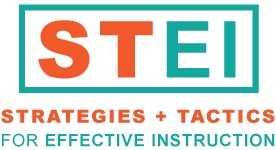Back to: Delivering
Learning is enhanced when students are given immediate, frequent, explicit feedback on their performance or behavior. When they do something correctly, students should be told so. Supportive feedback lets a student know that he/she did what was expected; it supports the performance by letting the student know that what was done was done correctly. By the same token, when students do something incorrectly, their performance should be corrected. Corrective feedback lets the student know that he/she did not do what was expected; it provides information to be used to redirect the student toward correct performance and reduces the likelihood of practicing errors. Diffuse, nondirected feedback leaves students wondering, and it should be avoided.
Dignify student responses
Even though students need corrective feedback for wrong responses, the very act of responding can be dignified by the type of statement made by the teacher prior to correcting the error. Some statement examples are: “I can tell you are thinking about the lesson, but let me help you correct your answer,” or “Thank you for trying but the right answer is ….” An abrupt “No, that’s not right!” may cause the student to stop giving any responses.
Use variety when providing feedback
Avoid overuse of statements like “Good,” “Right,” or “O.K.” Vary supportive feedback with statements such as “Way to go,” “Perfect,” “Right on target,” or “Correct answer.” Use gestures to communicate correctness. A wink or a thumbs up also lets the students know they have responded correctly.
Prevent students from practicing errors
It is quite apparent that practice improves performance for desirable skills, but unfortunately, practice also strengthens error responses. If students make an error that appears to be due to an incorrect association, correct the error immediately. Then provide a prompt or cue to assure that when the response is called for again, the correct response occurs, and the error is not practiced. This situation often occurs in reading when students confuse similar words such as “and” and “sand.” Prompting these words with a beginning sound clue can prevent the student from continuing to make errors on the word discrimination. Gradually fade out prompts as success is assured.
systematically return to responses
When students make an error on a response, correct the error and then systematically call for that same response until success occurs consistently. A systematic plan could involve returning to the response after one different request, then returning after two different requests, then after three, and so on. Gradually lengthening the time as well as increasing the amount of intervening information between the return will assure that the response has been corrected. For example, if students are recalling math facts and an error is made, give the correct answer, go to the next fact, return to the fact that was missed, then do the next two facts followed by a return to the original fact. Continue to increase the number of facts practiced prior to returning to the original fact. If an error reoccurs on the same fact at some point during this systematic return process, correct the error again and drop back to the beginning of the systematic plan.
check first responses on independent practice
When students begin independent practice, have students do the first item and immediately check all responses. Have them do the second item and again immediately check all responses. At this point, students who were correct on the first two can continue with some assurance that they will be successful. More guided practice can be provided for students who made errors. This strategy prevents students from practicing errors on several problems before receiving corrective feedback. An important note: Many students require at least 15-20 correct trials before “learning” a new fact or skill. Some students require a few less, but some require many more. It is better to err on the side of requiring more correct responses before moving to new content or assuming mastery.
